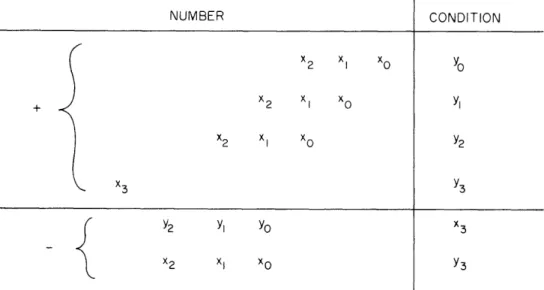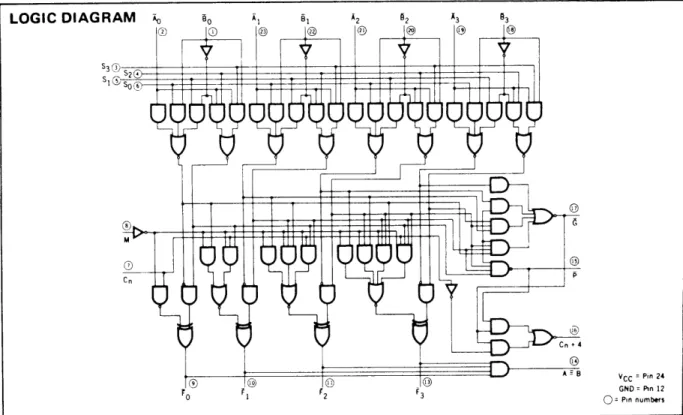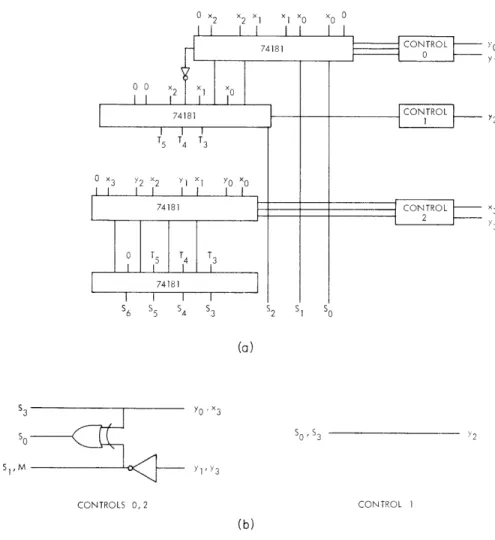Prof. M. Eden Prof. J. Allen Prof. B. A. Blesser Prof. T. S. Huang Prof. F. F. Lee Prof. S. J. Mason Prof. W. F. Schreiber B. S. Barbay J. Bonn W. T. Borroz J. E. Bowie B. E. Boyle P. Coueignoux J. R. Ellis, Jr. I. S. Englander A. AI. Fakhr A. E. Filip S. G. Finn W. B. Grossman D. W. Hartman
Academic and Research Staff Prof. D. E. Troxel Prof. I. T. Young Dr. R. R. Archer Dr. G. H. Granlund Dr. E, G. Guttmann Dr. L. P. A. Henckels Dr. K. R. Ingham Dr. J. I. Makhoul Graduate Students M. Hubelbank F. H. Ives J. W. Klovstad H. S. Magnuski L. A. Marks P. L. Miller B. Alinkow O. R. Mitchell, Jr. J. A. Myers D. O'Shaughnessy R. A. Piankian G. Poonen R. S. Putnam R. San Antonio Dr. D. M. Ozonoff Dr. O. J. Tretiak F. X. Carroll Deborah A. Finkel E. R. Jensen J. W. Modestino J. S. Ventura R. J. Shillman 1). G. Sitler J. R. Sloan A. A. Smith R. I). Solomon M. Sporer J. H. Stahler W. D. Stratton H-m. D. Toong K. P. Wacks Y. D. Willems H. M. Wolfson K. HI. Yung
A. NEW HIGH-SPEED MULTIPLIER DESIGN
With the advent of MSI and LSI integrated circuit technology, there is no doubt that digital multipliers of very high speed can be achieved, once it is agreed what should be incorporated in these chips.l In the meantime, we can achieve a very fast design by simultaneously exploiting the mathematical structure of binary two's-complement mul-tiplication and existing
AISI
circuits which can be adapted in a natural way to the struc-ture of this task. Accordingly, we shall show that the expression for binary multiplication can be rewritten to suggest use of the 74181 Arithmetic Logic Unit (ALU) in a straight-forward way that achieves high speed, simple layout, and very little logic external to the ALU array.In order to display the desired structure of multiplication, we shall consider the multiplication of two 4-bit two's-complement numbers. Let each such number be repre-sented as
This work was supported by the National Institutes of Health (Grant 5 P01 GI114940-05), and by the Joint Services Electronics Programs (U.S. Army, U.S. Navy, and U. S. Air Force) under Contract DAAB07-71-C-0300).
(XI. COGNITIVE INFORMATION PROCESSING)
Z - z3z2 zlz0 = -23z + 22z2 + 21z1 + 20zo'
where each z. is either 1 or 0, so that the product of two such numbers is 1
XY = 26x3Y3 - 25(x 3Y2+x2Y3) + 24(-x 3Yl+x2Y2-x 1Y 3)
+ 2 3(-X3Yo+x2Y +xY1 2-XoY3)
+ 22(x 2yo+xY +xo Y2)+ 21(X1Yo+ XYo 1)+ 20xoy
This sum is commonly arranged in an array in which each column contains factors of like powers of 2, as in Fig. XI-1. The factors can be further rearranged, as
-x 3Y0 + x2Y0 + x1y0 + x
0
-x3 1 + x2Y
1 + xlY1 + x0Y1
-x3Y2 + x2Y2 + xlY2 + x0YZ
+x3Y3 - x2y3 - x1 3 - x0Y3
Fig. XI-1. Array representation of two's -complement multiplication.
x2Y0 x1Y0 x0o 0 x2Y1 xlY 1 x
1
x2 2 x 1 2 x0Y2 x3Y 3 x3Y2 x3y1 x3 y3 x2Y3 x1Y3 x0Y3shown in Fig. XI-2, in order to group positive and negative terms. At this stage, each row has a constant factor for each term such as yo for the top row, and these can be factored out as bits that control the conditional inclusion of a given row in the final sum.
Thus, in Fig. XI-3, the top row (x2 x1 xo) will be added into the sum just in case Yo = 1, and similarly for the other rows. Figure XI-3 also shows 6 conditional terms to be summed, but one of these, x3Y3, affects only the most significant bit
position. If this term is included in any other row (say, row 6), the only change
NUMBER CONDITION x2 xI xO x2 xI xO x2 xI xO Y2 x3 Y3 . Y2 Yl
YO
×3 x2 XI XO Y3 Multiplication control bits.array, grouped by rows and their respective
(((A + B) + C) - (D + E))
Fig. XI-4.
Illustrating the parallel nature of the multiplication task.
Fig. XI-3.-- t 0
t3
- - - t 1'
(XI.
COGNITIVE INFORMATION PROCESSING)
in the final result might be a carry out of the most significant bit. When sign exten-sion is not desired, it is thus possible to incorporate the x3Y3 term in row 6, and
we are left with just 5 rows to sum. It is this representation of the product as a sum of conditional terms that can be exploited by the ALU design.
Having rewritten the product as a sum of terms, each conditioned on a control bit, the next step is to minimize the sum-and-carry delays by exploiting the inher-ent parallelism of the array. Referring to the five rows as A through E, Fig. XI-4 shows how a tree structure permits simultaneous sums to be computed, rather than performing each indicated sum in serial, left-to-right order. In Fig. XI-4, each box denotes an ALU adder, and we assume that each add is completed in A seconds. During the first A seconds two adds are completed, followed by one add in each of the two succeeding intervals. There are two advantages in this scheme. First, the total delay would be 4A seconds if the adds were done serially, but when the parallelism is utilized, only 3A seconds of delay result. More generally, for larger sized numbers N bits long, a similar binary tree would lead to (log2 N)A seconds
delay, whereas a serial procedure would require (N-1)A seconds delay. For N = 16, the saving is A(15-4) = llA, a very substantial figure. When N is not a power of 2, some branches of the full binary tree are pruned, but the saving in time because of parallelism is still obtained. The second advantage is that the binary tree arrangement can be implemented in a straightforward and natural way by using the 74181 ALU, 24-pin ISI package.
The 74181 ALU, shown in Fig. XI-5, operates on two 4-bit inputs in a manner prescribed by the four control bits, So through S3 , and the Mode Control bit MI, to produce a single 4-bit output. As shown in Fig. XI-6, all of the needed control functions can be realized by appropriate use of So through S3 , MI, and C , the last
being the input carry to the least significant bit. Note that only the double condi-tional sum, (A if z) + (B if y), requires extra circuitry to translate the condition bits (z and y) into ALU controls, but that this circuitry is very simple, containing only an XOR gate and an inverter.
Figure XI-7 shows the complete design for a 4 X 4 multiplier, in which the con-trol circuitry is shown in detail. Depending on the size of the multiplier desired,
extra time savings may be realized by appropriate partitioning of the array and insertion of carries, but the basic details remain the same. The authors have designed 16 X 16 and 16 X 24 arrays, which illustrate further refinements. These designs are available to the interested reader.
A further advantage of the ALU is its wide availability. Originally, it was introduced in TTL, but Schottky TTL and MECL 10,000 versions are now
avail-able. Worst-case multiplication times will depend on which one of these pack-ages is used, but a 16 X 16 design should yield a completion time of 95-100 ns
BASIC FUNCTION CONTROL SIGNALS S1 2 S3 M 0 1 1 0 0 1 x A 0 0 0 0 0 1 B 0 1 0 1 1 x A+B 1 0 0 1 0 1 A-B 0 1 1 0 0 0 CONTROL FUNCTION A+B A- B A+(B if y) (A if z)+(B if y) I 0 y ZE0y
(XI. COGNITIVE INFORMATION PROCESSING) 74181 CONTROL ( y 0 0 x2 xI x0 I 1 I I 1 74181 CON TROL y2 T5 T4 T3 0 x3 Y2 x2 Y1 X Y0 x0 74181 CONTROL x3 2-0 5 T4 T3
74181
S 6 S5 4 S3 S2 S1 SO (a) 3 So ,S3 2 S1 M 1 y73 CONTROLS 0, 2 CONTROL 1 (b)Fig. XI-7. Four by four multiplier block diagram, with external control circuitry.
in Schottky TTL. This is considerably faster than the performance obtainable from specialized multiplier packages, such as the Fairchild 9344 or the Advanced Micro Devices AM 2505. Since the ALU package has many uses, it is relatively inexpensive, particularly considering the resulting multiplier speed. The package count, and hence power, is high (approximately N(N+1)/4 for an NXN multiply; for N= 16,69 ALU's were required) but layout is simple, and no other design incorporating standard commercial
MSI packages has been able to yield the speed of this ALU array.
Certainly faster or cheaper multipliers have been built. The ALU in a binary tree, however, appears to be an optimal choice when very high speed is desired from standard commercial packages.
J. Allen, E. R. Jensen References
1. S. D. Pezaris, "A 40-ns 17-bit by 17-bit Array Multiplier," IEEE Trans. on Com-puters, Vol. C-20, No. 4, pp. 442-447, April 1971.



